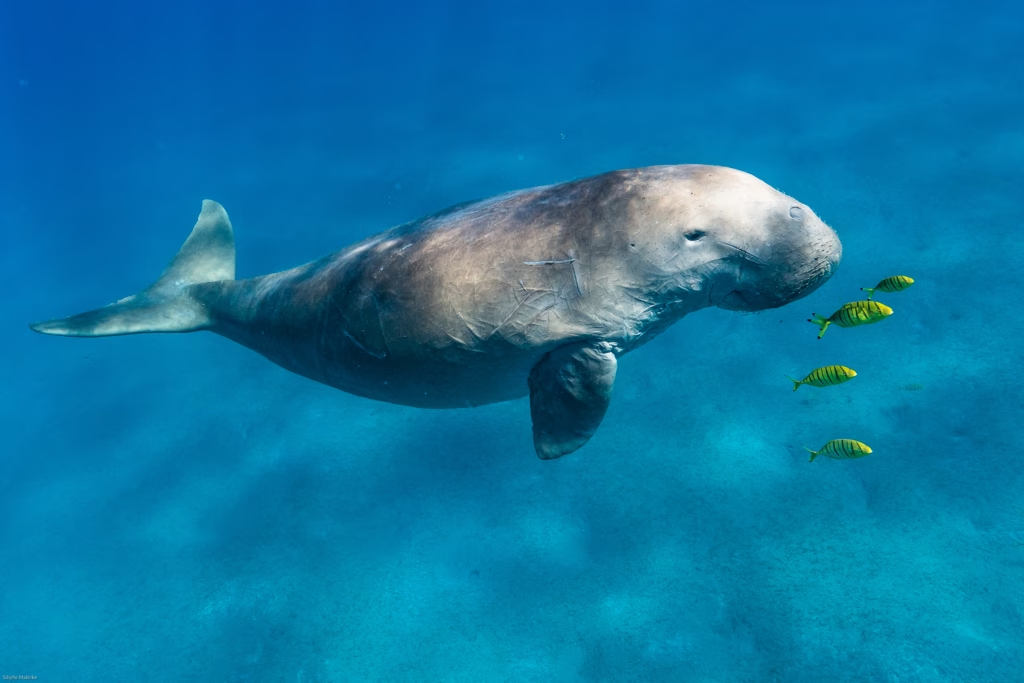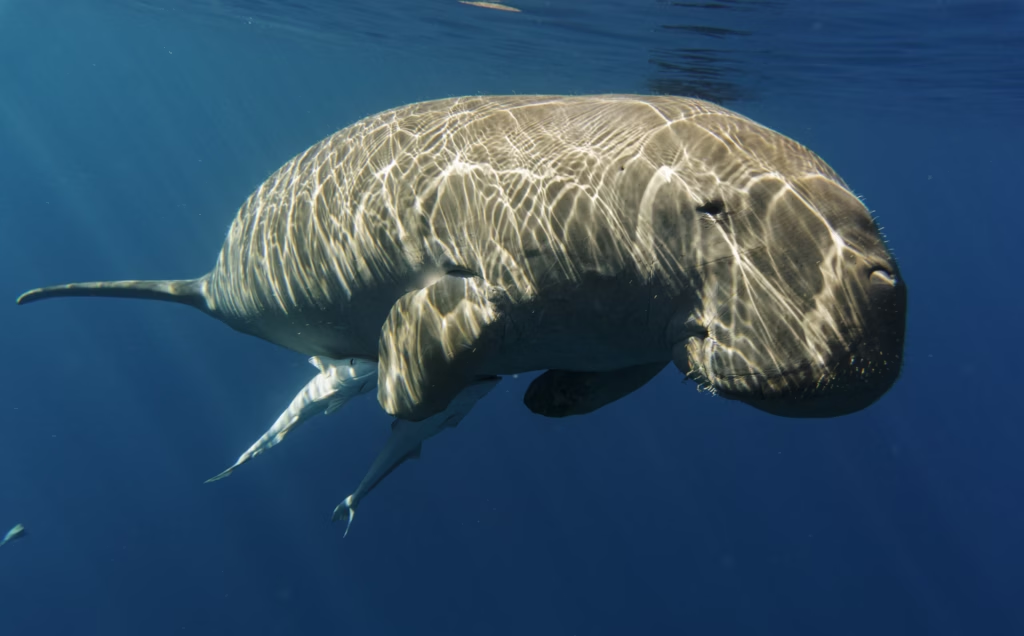Table of Contents
What is a Dugong?

The dugong (Dugong dugon), often called the “sea cow,” is a gentle marine mammal belonging to the order Sirenia. It is the only surviving member of the family Dugongidae, making it a living relic of ancient seas. The name “sirenian” originates from myths of mermaids, as early sailors often mistook dugongs for mystical sea maidens when they saw mothers swimming while cradling their calves.
With a rotund body reaching up to 3 meters in length and weighing more than 400 kilograms, dugongs may look heavy and slow, but in fact they glide gracefully in shallow tropical waters. Their paddle-shaped fluke resembles a dolphin’s tail, and their downturned upper lip is perfectly adapted for grazing on seagrass. This unique feeding behavior has earned them the nickname “gardeners of the sea.”
Habitat: Where Dugongs Still Survive
Dugongs are distributed across the Indo-Pacific region, from the eastern coast of Africa, through the Indian Ocean, to the Pacific waters of Australia. They rely entirely on seagrass meadows, which serve as their primary food source and habitat.
In Thailand, dugongs are found exclusively in the Andaman Sea. The most important population resides in Trang Province, particularly around Koh Libong, Koh Muk, and Koh Kradan, where extensive seagrass beds provide a reliable food supply. This has given Trang the reputation as the “Dugong Capital of Thailand.” Smaller populations are also found in Phang Nga, Krabi, and Satun, but in far fewer numbers.
Diet and Daily Life
Dugongs are strict herbivores, feeding almost entirely on seagrasses such as Enhalus acoroides (tape seagrass) and Thalassia hemprichii (dugong grass). An adult dugong can consume up to 40 kilograms of seagrass per day, maintaining the health and renewal of seagrass ecosystems.
They are shy, slow-moving creatures that usually live alone or in small groups, though mother-calf pairs are a common sight. Dugongs can dive up to 10 meters and hold their breath for as long as 6 minutes, although they generally stay close to the surface in shallow coastal waters.
Why Are Dugongs Endangered?
Despite their long lifespan of up to 70 years, dugongs reproduce very slowly. Females are pregnant for 13–14 months and give birth to a single calf only once every 2–5 years. This slow reproduction makes it extremely difficult for populations to recover from losses.
Major threats include:
- Loss of seagrass habitats due to coastal development and pollution
- Entanglement in fishing nets and destructive fishing gear
- Collisions with speedboats and tourist vessels
- Ingestion of plastic waste and marine debris
The International Union for Conservation of Nature (IUCN) has listed dugongs as Vulnerable, while in certain regions such as the Philippines and Japan, their populations are considered critically endangered or locally extinct.
Ecological Importance: Why Dugongs Matter
Dugongs are a keystone species in marine ecosystems. Their grazing maintains the balance and productivity of seagrass meadows, which serve as vital nurseries for fish, crabs, and shrimps, while also acting as significant carbon sinks (Blue Carbon) that help mitigate climate change.
Simply put: if dugongs thrive, it means the sea is healthy. Their presence reflects the strength of the entire marine food chain.

Dugongs in Culture and Folklore
Across Southeast Asia, dugongs hold cultural significance. In Thailand, local sea nomads such as the Moken view dugongs as sacred animals, and harming them was believed to bring misfortune. Globally, dugongs have been tied to the origins of mermaid legends, as their nurturing behavior with calves resembles a mother carrying a child.
Dugong Conservation in Thailand
Thailand has implemented multiple conservation measures to protect dugongs:
- Establishing protected zones for seagrass beds
- Banning harmful fishing equipment in critical habitats
- Tracking dugongs with satellite technology to study migration and feeding patterns
- Coastal clean-up campaigns and plastic reduction initiatives
- Community involvement, with local residents of Koh Libong now known as “Dugong Guardians”
The story of “Mariam,” a baby dugong that captured national attention in 2019 before tragically dying from plastic ingestion, became a turning point. It raised awareness of marine plastic pollution and reinforced the urgency of dugong conservation in Thailand.
Dugongs and Responsible Tourism
Today, eco-friendly island tours are one of the most powerful tools for dugong conservation. By supporting tours that prioritize sustainability, such as Love Andaman, travelers can experience the beauty of the Andaman Sea while contributing to marine protection.
Simple actions—reducing plastic use, choosing eco-certified operators, avoiding high-speed boating in seagrass zones—can make a difference. Every traveler who cares about dugongs plays a part in protecting this gentle sea mammal for future generations.
Conclusion: A Symbol of a Healthy Andaman Sea
The dugong is more than just a marine curiosity. It is a living symbol of balance and biodiversity in the Andaman Sea. Protecting the dugong means preserving seagrass meadows, marine life nurseries, and the overall resilience of ocean ecosystems.
So, the next time you visit Trang or the Andaman coast, remember: beneath the turquoise waters, a sea cow may be grazing quietly, reminding us of the beauty and fragility of our oceans—and our shared responsibility to protect them.
